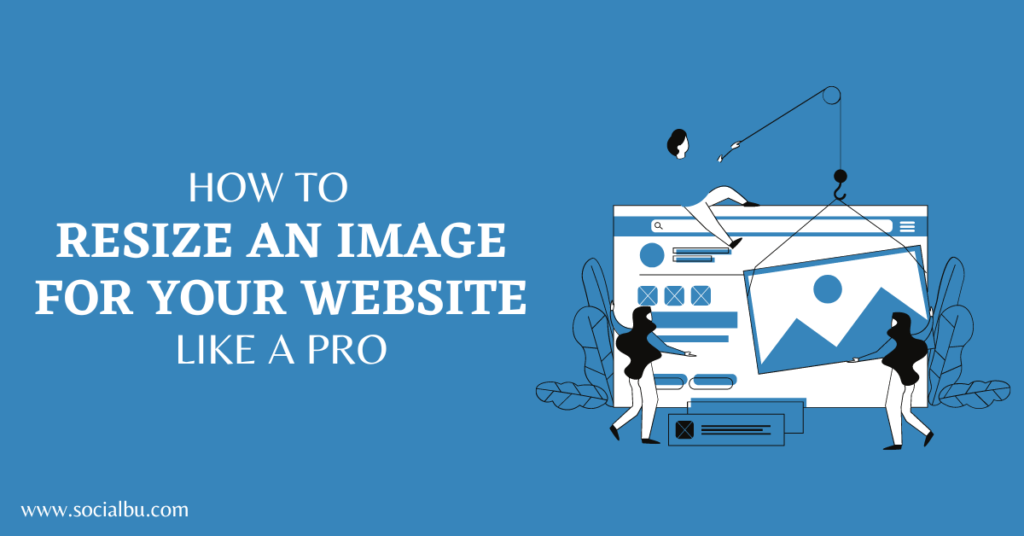Image resizing can make or break the overall aesthetics of your website. Usually, a picture is used to qualify a piece of content to make it easier to understand for the audience.
However, there are some other purposes that an image serves, but it all depends on the image type. For example, a banner image is used to educate the audience about the core services of a brand.
As there is a different image size limit for social media, a product image is used to showcase the visual presentation of an item. But, one thing that decides the impact of an image on your website is its size; that’s why we need to resize an image.
Therefore, we will discuss why image resizing is required before moving on to how to do it.
Reason Behind Image Resizing

Image resizing is necessary because it helps get an image in the optimized size. It is so because if image size is optimized, it will enhance the site speed, improving the user experience.
On the contrary, if you upload an image in a random size instead of an optimized size, the user experience will get spoiled on your site.
It is so because a small size will affect the image resolution, making it difficult to understand its content. And a large size will lower the site speed as it will take too long to load; hence users will get frustrated and leave your platform.
Thus, traffic flow on your site will get disturbed. That’s why uploading an image in the optimum size on your site is essential.
Therefore, this blog post will discuss how you can resize an image for your site like a pro to get it in the proper size.
Ways to Resize an Image
There are two methods that you can use to resize an image. One is the manual approach, in which you manually change the dimensions of an image, and the other is with the help of an image resizer. Both of these methods have specific significance.
So let’s describe both of them briefly.
1. Manual Image Resizing
This method can be easy but inconvenient because you must do some prior research to get your photo in the correct size.
However, the good thing about this approach is that every piece falls in the right place, from image size and image resolution to image responsiveness when you opt this way.
Below are the gradual steps to resize an image for your website manually.
Determine The Target Size
The first thing you have to decide is the dimensions (Length*Width) of an image in pixels you need. This way, it can be correctly and aptly displayed on your website.
This process is essential for optimizing the image for web use because if your picture isn’t in the perfect size, it will affect your performance negatively.
Therefore, you must thoroughly comprehend the purpose of an image. It helps you determine what size will work best for it. It is so because there are standards for each image type that you must follow to get outstanding results by using different images on your site.
Usually, the photos we receive from image designers are in MBs. However, for website use, you must reduce the image size to KB to maintain the balance between image size and resolution.
Luckily, Picsart’s AI Image Generator can help you with this process. This tool enables you to choose the exact resolution for your images and automatically generate them for you. It also ensures that the quality of the images remains intact and does not have a negative effect on your website performance.
Preserve Aspect Ratio
While resizing your image, you must preserve the aspect ratio. It stands for maintaining the proportional relationship between the width and height of an image. It is essential because when you resize an image, changing its dimensions’ can alter its appearance and make it look distorted.
However, preserving the aspect ratio allows you to resize the image to maintain its original shape and proportions. Hence, the image quality stays the same.
Select Appropriate Resolution
Choosing an appropriate resolution in image resizing is determining the number of pixels per inch (PPI). The resolution of an image plays a decisive role in shaping its clarity and sharpness.
If the resolution is too high, the image size will be large, slowing down the site’s load time and negatively impacting the user experience. On the other hand, if the resolution is too low, an image may appear blurry, reducing the overall quality of an image.
So, it is crucial to pick a formidable resolution while resizing an image. Ensure it seems clear and sharp on various screen sizes and devices. Generally, an image for website use is 72 PPI, the standard screen resolution.
However, the appropriate resolution may vary depending on the specific requirements of a website and the images you are using in it.
2. Image Resizing Using Online Tools
Manual resing takes a lot of time, so you can opt for an alternate way and resize your images with the help of an image resizer online. This way, you don’t have to grind through an intricate process.
Instead, you open a photo resizer, import your desired file, and set your required dimensions, and it will resize your image as per your instruction. For example, you can resize an image for Google Display & Email and Blog visual assets. The best thing about this approach is that you resize multiple photos in one shot.
Moreover, you don’t have to install an application or software on your device to use it. All you need is a strong internet connection to resize your images. You can easily find an online photo resizer by exploring the internet and resizing your images on your smartphone and desktop.
However, if you fail to achieve desired outcomes with image resizing, such as optimum image file size or proper image resolution, there is another way out.
The solution to Tackle File size Issues
![]()
Image compression is an answer to achieving a delicate balance between image size and resolution. It helps adjust an image’s size while keeping the quality intact.
That’s why the results you get with the help of an image compressor are highly reliable. It is because the visual appearance matches the original images. In addition, it permits compressing images in a specific size.
For example, you can compress JPEG to 50KB, and images on a website are in JPEG format.
Conclusion
Image resizing seems arduous. But it is a mandatory practice if you aim to get a reward while creating an image for your website. Otherwise, your efforts will go down the drain if rough image size spoils the user experience on your site. Additionally, it will increase the bounce rate.







